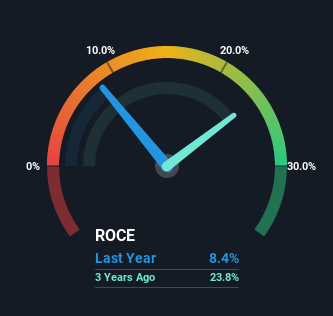Cabbeen Fashion's (HKG:2030) Returns On Capital Not Reflecting Well On The Business

When researching a stock for investment, what can tell us that the company is in decline? Typically, we'll see the trend of both return on capital employed (ROCE) declining and this usually coincides with a decreasing amount of capital employed. This combination can tell you that not only is the company investing less, it's earning less on what it does invest. So after glancing at the trends within Cabbeen Fashion (HKG:2030), we weren't too hopeful.
Understanding Return On Capital Employed (ROCE)
For those that aren't sure what ROCE is, it measures the amount of pre-tax profits a company can generate from the capital employed in its business. Analysts use this formula to calculate it for Cabbeen Fashion:
Return on Capital Employed = Earnings Before Interest and Tax (EBIT) ÷ (Total Assets - Current Liabilities)
0.084 = CN¥122m ÷ (CN¥2.3b - CN¥818m) (Based on the trailing twelve months to June 2022).
Thus, Cabbeen Fashion has an ROCE of 8.4%. Ultimately, that's a low return and it under-performs the Luxury industry average of 11%.
See our latest analysis for Cabbeen Fashion

While the past is not representative of the future, it can be helpful to know how a company has performed historically, which is why we have this chart above. If you're interested in investigating Cabbeen Fashion's past further, check out this free graph of past earnings, revenue and cash flow.
The Trend Of ROCE
There is reason to be cautious about Cabbeen Fashion, given the returns are trending downwards. To be more specific, the ROCE was 18% five years ago, but since then it has dropped noticeably. And on the capital employed front, the business is utilizing roughly the same amount of capital as it was back then. This combination can be indicative of a mature business that still has areas to deploy capital, but the returns received aren't as high due potentially to new competition or smaller margins. If these trends continue, we wouldn't expect Cabbeen Fashion to turn into a multi-bagger.
While on the subject, we noticed that the ratio of current liabilities to total assets has risen to 36%, which has impacted the ROCE. If current liabilities hadn't increased as much as they did, the ROCE could actually be even lower. Keep an eye on this ratio, because the business could encounter some new risks if this metric gets too high.
What We Can Learn From Cabbeen Fashion's ROCE
In summary, it's unfortunate that Cabbeen Fashion is generating lower returns from the same amount of capital. Investors haven't taken kindly to these developments, since the stock has declined 35% from where it was five years ago. That being the case, unless the underlying trends revert to a more positive trajectory, we'd consider looking elsewhere.
On a final note, we found 4 warning signs for Cabbeen Fashion (1 is concerning) you should be aware of.
For those who like to invest in solid companies, check out this free list of companies with solid balance sheets and high returns on equity.
New: AI Stock Screener & Alerts
Our new AI Stock Screener scans the market every day to uncover opportunities.
• Dividend Powerhouses (3%+ Yield)
• Undervalued Small Caps with Insider Buying
• High growth Tech and AI Companies
Or build your own from over 50 metrics.
Have feedback on this article? Concerned about the content? Get in touch with us directly. Alternatively, email editorial-team (at) simplywallst.com.
This article by Simply Wall St is general in nature. We provide commentary based on historical data and analyst forecasts only using an unbiased methodology and our articles are not intended to be financial advice. It does not constitute a recommendation to buy or sell any stock, and does not take account of your objectives, or your financial situation. We aim to bring you long-term focused analysis driven by fundamental data. Note that our analysis may not factor in the latest price-sensitive company announcements or qualitative material. Simply Wall St has no position in any stocks mentioned.
About SEHK:2030
Cabbeen Fashion
A fashion casual menswear company, designs and sells apparel, shoes, and accessories for men, women, and kids under the Cabbeen, Cabbeen Urban, and 2AM brands in the People’s Republic of China.
Flawless balance sheet with proven track record.
Market Insights
Community Narratives




